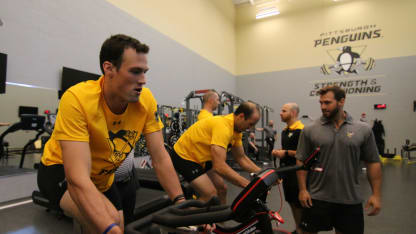Pens use recovery days to combat fatigue

The Pens are feeling the effects of that challenge. Pittsburgh, playing in its fourth game in six days and third game in four days, appeared fatigue during a 5-2 loss to the Detroit Red Wings on Sunday afternoon.
"This time of year it's just part of the game," head coach Mike Sullivan said following the setback. "We have to find ways to have success through the process. I don't look to excuses. We're looking for solutions out there. We have to find ways to be successful through these types of challenges in our schedule."
Compounding the problem are several additional factors for the Pens. The team had a long run in last year's postseason, culminating in a Stanley Cup championship, thus a shorter offseason than most teams to recover. Also with the World Cup of Hockey and the NHL's "bye week" every NHL team is playing a more condensed schedule.
"That's the nature of the schedule this year," Sullivan said. "We go through stretches where you play a lot of games in a short period of time. Every team goes through it. We're not different than any other team."
The coaching staff, trying to safeguard against the players physically burning out, has given the team numerous days off and/or off-ice workouts only.
"We're trying to give them enough rest," Sullivan said. "We have a strength and conditioning staff that advices us on the types of practices we run and on how we're preparing these guys to play."
When the team has a day off, that means it is a complete day off away from the rink (not applicable to injured players requiring rehab). It gives the players a chance to not only rest physically, but to mentally take some time away from the game and recharge.
For days when the coaching staff has the players participate in an off-ice workout, the strength and conditioning staff - Andy O'Brien and Alex Trinca - treat those days as off-ice recovery days.
"We will typically do some sort of 'active recovery,'" Trinca, the team's strength and conditioning coach, said. "Which usually consists of a combination of movements - jogging, skipping, shuffling, lunging - stretching, specific muscle activation, as well as passive recovery modalities like a cold tub."
Some players will also use muscle stimulating devices and/or compression devices which incite low-intensity muscle contractions without doing actual exertion. Most of the players will also do self-muscle release techniques, like using a foam roller, vibration devices or softballs.
Players will also check in the medical staff to deal with any lingering issues, as well as using athletic therapists for soft tissue work, flushing, etc. There is a formal itinerary for such sessions, but each player has their own specific plan.
"Overall our philosophy is to alleviate muscle tension, as well as increasing nutrient rich blood flow through the legs and get some movement around the joints," Trinca said.
Science and literature in the field of strength and conditioning show the importance of rest and recovery time for professional athletes. Adequate rest time is needed in order to maintain a high level of performance. Studies show that inadequate recovery time leads to diminished performance and breakdown, known as "overtraining."
"Recovery time is when the athlete's system is allowed to recharge and adapt to any stress placed upon it," Trinca said. "After periods of heavy competition - three games in four nights - the body needs to physically recover in order to continue to perform. If we just continued to play games the body would inevitably shut down and fail."
Trinca and O'Brien monitor the players throughout the entire season, both through data metrics and general player feedback.
Players undergo extensive fitness testing at the beginning of training camp and those data markers are tracked to determine individual fitness levels and needs. The players also wear heart monitors during every practice to track the cardiovascular stress on a day-to-day basis.
And communication is important. The staff is in constant contact with the players regarding everything from their sleeping patterns to nutrition habits to energy levels. The staff uses all of this information in their assessments and recommendations.
"It is multiple data points that persist over time which might lead us to make a decision or change something," Trinca said. "We never make impulse decisions based on one marker from one data source.
"At the end of the day, the most powerful tool we use is our voices and intuition. We rely on scientific measurements to provide some insight into what is going on to help inform our opinions on players' performances."


















































